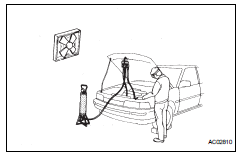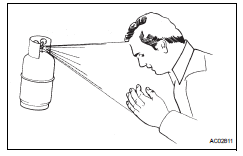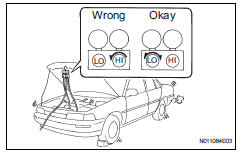Toyota RAV4 (XA40) 2013-2018 Service Manual: Precaution
- If any of following conditions are met, keep engine idling with a/c on (engine speed at less than 2000 rpm) for at least 1 minute:
- Refrigerant gas has been refilled or a/c parts have been replaced.
- A long time has elapsed since the engine was stopped.
Notice:
If the engine speed exceeds 2,000 rpm, the a/c compressor may be damaged.
- Do not handle refrigerant in enclosed areas or near open flames
- Always wear eye protection

- Be careful not to get liquid refrigerant in your eyes or on your skin

If liquid refrigerant gets in your eyes or on your skin:
- Wash the area with lots of cold water.
Caution:
Do not rub your eyes or skin.
- Apply clean petroleum jelly to the skin.
- Go immediately to a physician or hospital for professional treatment.
- Never heat container or expose it to open flame
- Be careful not to drop container or subject it to physical shocks
- Do not operate compressor with insufficient refrigerant in refrigerant system

If there is not enough refrigerant in the refrigerant system, oil lubrication will be insufficient and compressor burnout may occur. Necessary care should be taken to avoid this.
- Do not open high pressure manifold valve while compressor is operating
Open and close only the low pressure valve. Opening and closing the high pressure valve could cause the charging cylinder to rupture.
- Be careful not to overcharge system with refrigerant
If the refrigerant is overcharged, it causes problems such as insufficient cooling, poor fuel economy and engine overheating.
- Do not operate engine and compressor without refrigerant
Notice:
This may damage the inside of the compressor.
Other materials:
Installation (2005/11-2006/01)
Install front drive shaft assembly lh
Coat the spline of the inboard joint shaft with gear
oil.
Using a brass bar and hammer, align the shaft
splines in the drive shaft.
Notice:
Set the snap ring with the opening side facing
downwards.
Be careful not to damage the oil s ...
Short in driver side squib 2nd step circuit
Description
The driver side squib 2nd step circuit consists of the center airbag sensor,
the spiral cable and the
steering pad.
The circuit instructs the srs to deploy when the deployment conditions are met.
These dtcs are recorded when a malfunction is detected in the driver side squi ...
Exhaust pipe
Installation
Install front exhaust pipe assembly
Using a vernier caliper, measure the free length of
the compression spring.
Minimum length:
41.5 Mm (1.634 In.)
If the length is less than the minimum, replace the
compression spring.
Install a new gasket by hand so that its ...


